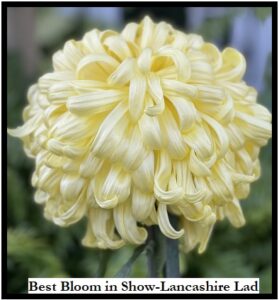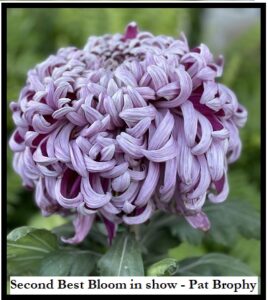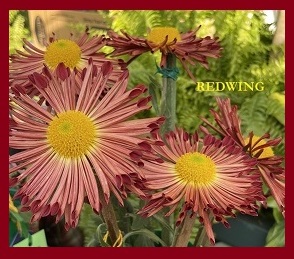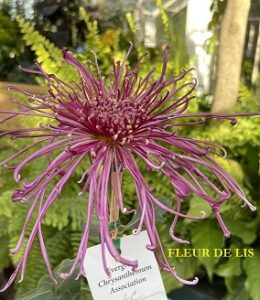Once the buds have broken the membrane and some petal tips are showing color it’s imperative to get the pots into or under some kind of shelter where they will remain through final bloom development. The basic idea is to protect the blooms from rain, wind and dew, and provide adequate temperature control and ventilation. The watering and fertilization program must also be modified to assure proper bloom development, and lastly we need to continue with pest management and fungus control throughout the bloom development. Avoid spraying insecticides or fungicides directly on the blooms.
Housing/Sheltering:
Sheltering of your plants is necessary throughout the bloom cycle to protect the blooms and plants from wind, rain and dew. Shelters come in a variety of sizes, names and shapes including porches, large overhanging eaves, garages, car ports, green houses or temporary wood /plastic structures. It’s highly advantageous to provide supplemental lighting in dark areas such as garages. There is more lighting information below.
Around Labor Day, when the buds are starting to break the membrane and show color, bring them in. Wash the pots thoroughly around the bottom to get rid of the crud moss and residue that have formed in your growing area. Clip off all excess roots that are hanging out the drain holes and pick off all old and damaged leaves, mostly around the bottom of the plant, that harbor pests and fungi.
Spray the plant with both a good fungicide and insecticide, taking care not to get any of the spray on the blooms. Watch for and destroy earwigs, worms, caterpillars etc. They can wreck blooms when they get on or inside.
Top-dress the pots for one last time. Add about ½ to ¾ in. of your 9” mix or some compost to the pot surface and level it. Top-Dressing the plants helps finishing the plants now and also promotes new root growth for next year’s cuttings. Now’s the time to cut off (not tear out) all new basil shoots that are developing, If your pot exhibited significant moss growth , add ½ tsp of Hydrated lime to the top dress mix to help sweeten the soil.
IMPORTANT COLOR ENHANCEMENT INFORMATION:
Optionally, to enhance the color in colored blooms (any blooms not white or yellow) add a single application of ¼ tsp of Ferrous sulfate (Fe2 So4) into the fertilizer solution when you water. Again, do this only one time per plant. In particular, Athabasca needs this Fe2,So4 to show a significant ring of pink tips on its blossom.
Lighting:
Considerably less light will be required during the bloom cycle but is still necessary to provide supplemental light in most cases where you have sheltered the plants. The opening blooms will not tolerate full sunlight through clear plastic or glass. And, colored blooms will tend to fade in direct sunlight. If you are finishing in a green house or similar structure, we recommend adding light filtration in the ceilings. To filter sunlight through glass or clear plastic you can purchase black screen like materials to put over your greenhouse roofs or you can pin light colored sheets across the ceiling. The sheets will also absorb the early morning dew that tends to collect in the cool mornings.
Light Supplements:
The most common and functional method is hanging 4’ or 8’ Fluorescent light fixtures in the ceiling. Plain white light lights work or if you choose you can buy Grow-lights which are reputed to be better. Don’t buy “Grow-Lux” lights unless you are very rich as they are a specific brand name light and very costly. You can run the lights all day, 8-10 hours, during the day or all night if you so choose. I prefer just the time during daylight hours.
Another clue that might help – In general reflexing varieties like it light and cool while Incurves usually like it warmer and less light.
Temperature:
Maximum sheltering temperature should be kept below 80 Deg. if possible. Temperatures above 80 degrees increase the probability of bloom damage and rot. If the shelter is exposed directly to the sun in early Sept. days the temperature within can skyrocket. That leads us into a discussion about ventilation
Ventilation and temperature:
Big fans can be used to increase ventilation and keep the temperature down. The fans also hopefully can bring in air from the shady side of the shelter to cool the overall area as well. Lining the inside of the shelter roof with old sheets or muslin will also reduce the heating and filter the sunlight. In general keeping the temperature between 50 deg and 70 deg. F is optimal for most of the finishing. In the last few weeks of October the night time temps may dip into the 40s which will probably accelerate bloom development. If your temperatures dip into the 30s you will probably get pinking on the edges of some blooms. You can contact Steve Joyner or Ron Elliott to discuss your specific shelter questions or ideas.
Staking and bud support:
Now’s the time to start cutting back to your final selection of laterals. Stake the stems securely to the support shingle and the support stake. Stake and tie up all selected laterals and add support shingles under the blooms. Keep moving the support shingle up under the bud/bloom as the stem grows. Being very careful not to snap off the bud, use the support shingle to straighten the bud neck and keep the bloom flat atop the stem. Finally, remove all side laterals as they appear on the selected stems below the bloom so that the bloom is all that is left.
Fertilizing and Watering:
For the bloom cycle, immediately after taking the bud reduce the mid-season fertilizer (10-20-10) to ½ strength. When you start to see color in the bud you can either switch to our late season fertilizer formulation (4-18-38) that is higher in Potash at a concentration of ½ tsp per gallon of water or you can mix ½ tsp of our mid-season fertilizer with ¼ tsp of Sulphate of Potash per gallon of water. The potash will harden off the plant and keep the bloom petals from being too soft. After the petals begin to drop it is safe to gradually increase the strength of this formula to promote blossom growth. Do not over feed. Note: It’s easy to overfeed the plant at this time, and produce ragged, cocked, or deformed blooms; or the bloom could actually crack at the stem just below the bloom. So, increase the fertilizer sparingly.
Watering is different at this stage also. Water more sparing using about 1 pint per watering and do not water when the temperature is over 75 deg. Water /fertilize from a bucket using a 1-pint jar or similar small container. Do not use a hose and scatter water everywhere on the shelter floor. Keep the finishing area dry and clean.




